
Garden
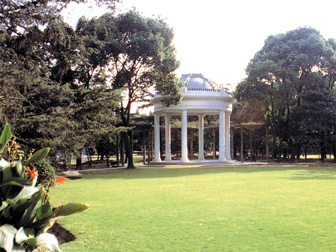
After the establishment of the people's republic of china, the club was used as the people's culture palace, the garden as a soccer field and sports field. In 1959, when Chairman Mao stayed here, a walking path was paved and trees were planted so that the garden became its present form. a domed pavilion was built there to match those on the club roof because formerly there were 2 domed pavilions on either side of the roof.

Stairs
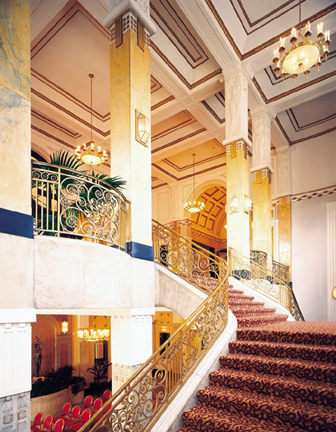
The stairs in the east entrance lobby leading to the second floor vividly reflect the popular art decoration trend of the old times of shanghai. The fine cut, metal railings were likely imported from France. On the landing of the staircase, there is a big window at the top. it was said that stained glass panes were initially used there. Sadly, all efforts to obtain drawings or data detailing these panes failed, so that the restoration could not be undertaken.

2F Foyer
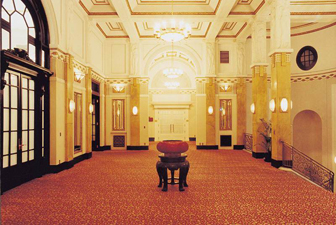
Nude female figures once again grace the tops of columns in the foyer. During the “Cultural Revolution”, these sculptures were concealed under a protective measure. The light fixtures here have frames of punched steel plates, which have been fitted with cut glass. Such fixtures were common in buildings along the Bund. These lights, however, did not provide enough light for the foyer, and therefore chandeliers were designed and manufactured in Vienna to replace them. The inset lights, made of wood and painted gold, were unusual and also impractical.

The Grand Ballroom
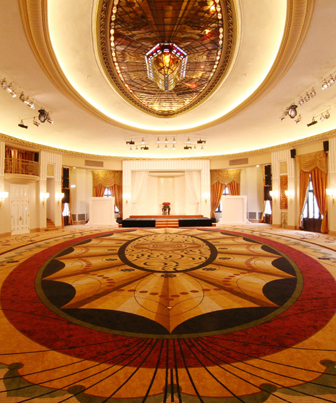
Since the 1920’s it has been the most prestigious Ballroom in Shanghai. The prominent feature was the elliptical, sunken dance area with an ingeniously designed spring floor. The recessed floor is now protected, but should the enchanting waltz and passionate tango again rise to capture the hearts of the people, the ballroom may be restored to its original magnificence. Another notable aspect of this room is the oval, stained decorative glass in the center of the ceiling. Shaped like the bottom of a boat, its beauty is truly inspiring.

The Small and Medium Function Rooms
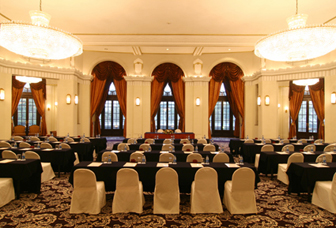
The function rooms retain much of their original splendor. In 1926, when the building was originally constructed, these rooms were connected by arched doorways. Later, they were divided into separate rooms by brick walls. The unusual wave-patterned plaster molding was added when the building became the People’s Culture Palace. The pattern is symbolic of rolling waves in the Yangtze River.

Balcony
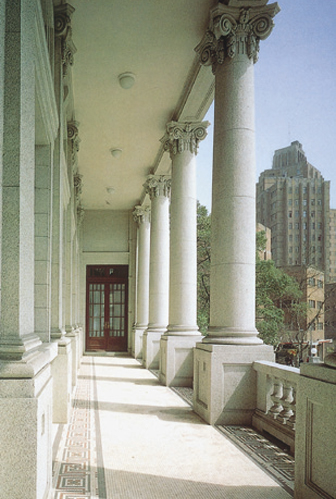
Originally, there were balconies across the front of both wings of the French club. It is said that the balconies had been enclosed with exterior walls and windows so that one could enjoy strolls in the rain. These walls and windows were removed to re-create the beautiful original balconies that now exist.

Architectural Highlights of Shanghai
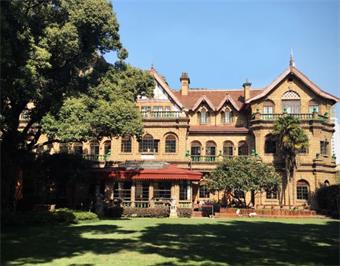
Dazzling light rays to cover up countless romantic traces of old Shanghai, hasty footsteps crumple disorderly and fade scraps of memories. The mission of this time’s tour is to guide you through this past surging storms and erstwhile incredible legends.
Bright spots along the route:
1) Moller Villa (No. 30 South Shaanxi Road)
This building with colorful walls and meticulously-crafted and splendid-looking Scandinavian details is the most exquisite one among over 1000 villas left in Shanghai today. Its architectural inspiration came from the dream of a girl, the beautiful daughter of Eric Moller.
2) Mansion Hotel (No. 82 Xinle Road)
On Xinle Road with an Orthodox Church, there is a majestic white western style building, it is the former residence of Du Yuesheng, the Godfather of Green Gang in old Shanghai. First constructed in 1932, this building was designed by French designer Lafayette, in response to invitation from Du Yuesheng in his most successful years. Its exterior is the most fashionable one among all neo-classicism architectures at that time.
3) Ba Jin’s Former Residence (No. 113 Wukang Road)
Tucked away in the shade of French plane trees, No. 113 Wukang Road is a house with independent entrance and courtyard in comfortably quiet and elegant surroundings. The “Fortune Teller” Ba Jin lived here for as long as half a century. Today, after weathering countless wind and rain, the Ba Jin’s Former Residence was restored to its original conditions, which completely preserves the life and work scenes of a master writer for one generation.
4) Huang Xing’s Former Residence (No. 393 Wukang Road)
Strolling down Wukang Road, near the crossing of Taian Road, there is a contemporary Apartment building. Masculine lines, Art Deco style dark brown mosaic wall tiling and relief on the wall surface make the Apartment stand out conspicuously. As the former residence of Huang Xing, it is also the place often visited by Sun Yat-sen, it is commonly called Huang’s Residence.

Listening • Hongkou
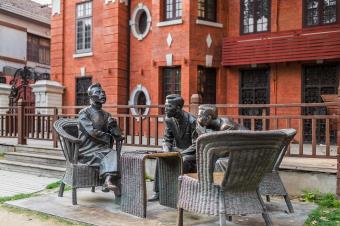
The place here witnessed the hard years of leading the Central Intelligence Agency by Zhou Enlai. The dedication of life by Japanese friends for the sake of peace and justice in anti-fascist war is well shown by tireless writing by truth-searching writers of the left-wing Writers’ League and other eternal waves. History may be a thing of the past, yet imperishable traces are enduring.
Bright spots along the route
1) Luxun’s Old Residence (No. 9 Lane 132 Shanyin Road)
8 yuan entry ticket, and a 10 minute introduction will leave you with a different story. Luxun’s diary tells us that Luxun held frequent rendezvous with a Soviet female spy here. Why? Join this route if you want to know the reason, while paying tribute to the great mentor Luxun a great way to experience the thrilling adventures of that age.
2) Martyr Li Bai’s Former Residence (No. 15, Lane 107 Huangdu Road)
“The Eternal Wave”, a classical revolutionary movie in the 1950’s, inspired generations of the Chinese population to devote themselves to the construction of New China. During the Liberation War period, he risked his life to install secret radio at No. 15, Lane 107 of Huangdu Road. The place here is a Dutch style townhouse which is relatively rare in Hongkou District. Under the white terror of KMT regime, the eternal wave narrates a story about a true hero of that time.
3) Site of the Left-wing Writers’ League (No. 2 Lane 201 Duolun Road)
With its white-line brick wall, the three-story western style building looks particularly pleasing to the eyes. Back then, China’s left-wing writers frequently held activities here. The birth of the Chinese League of Left-wing Writers signaled a new stage in the revolutionary literature movement. The memorial museum displays precious historical documents, photos, works and manuscripts of writers of the “Left-wing Writers’ League”, and martyrs’ mementos.
4) Duolun Road
Walking a few steps southward from Luxun Park, there is a meandering road resembling letter L. Stretching for no more than 550 meters, this road not only preserves a number of Shanghai style buildings with exotic flavors also it has former residences of many famous cultural celebrities whose fame are even spread to overseas countries. Duolun Road is a unique road with deep cultural background and rich cultural resources. Therefore it is acclaimed as the “Modern Cultural Town”.
5) Shanyin Road
The starting point for the intelligence work of Ozaki Hotsumi, a key member of the “Super Spy” Richard Sorge Team, began in Hongkou. Ozaki Hotsumi and Nakanishi Kou both lived on Shanyin Road. Looking back at this extraordinary period, the stories who took place here during the secret battle front in those eventful years are still soul-stirring.

Dialogue with Eileen Chang
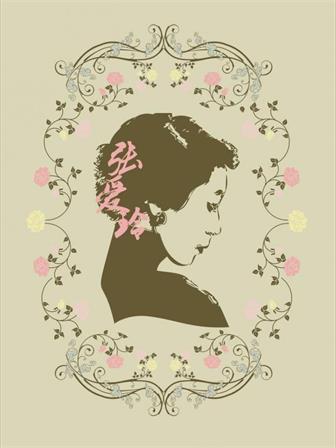
She has an indissoluble bond with Shanghai. She was born in Shanghai, grew up in Shanghai , her literature career began in Shanghai, she directed her first movie in Shanghai, her first love sprouted and ended in Shanghai……In a certain sense, it is Shanghai that brings her fame.
Bright spots along the route
1) Changde Apartment (No. 195 Changde Road)
When Eileen Chang returned from Hong Kong to Shanghai, she moved into Aidingdun Apartment, it was here that Eileen Chang completed a series of important works including “The First Incense Burnt”, “The Burnt Incense: The Second”, “Love In A Fallen City”, “The Red Rose and The White Rose”, plus the “The Golden Cangue”. The last one is acclaimed by Fu Lei as “one of the most beautiful harvests of our literature circle”.
2) Meiliyuan (Lane 379 West Yan’an Road)
The person loved by Eileen Chang lived at Meiliyuan (Beauty Garden), if you read “This Life This World”, you might feel there is another touch to the story. This book stages in “Meiliyuan”. The romance between Eileen Chang and Hu Lancheng began here.
3) Xiong Foxi Building
Leaving Meiliyuan, on the right hand is the Shanghai Theater Academy, previously the German Country Club for German expatriates; it is the place where Eileen Chang and Hu Lancheng frequently dated.

Encounter •Hudec
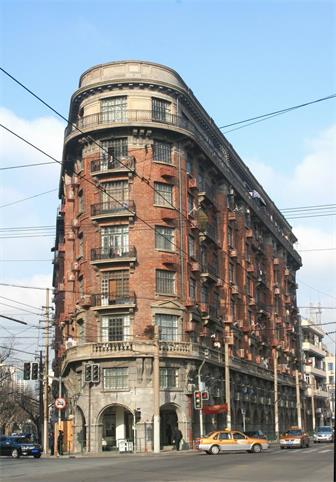
Bright spots along the route
1) Green House
This residence build for Wu Tongwen, the “King of Pigment” in Old Shanghai in 1939 was designed by Mr Hudec. It is the first residence with a private elevator in Shanghai. The Green House building resembles the shape of a “ship”, perhaps at that time Hudec was already homesick since “ship” might symbolize his longing for home. After the Green House, Hudec designed no more other buildings in Shanghai before leaving Shanghai quietly in 1947.
2) Grand Theater
The Grand Theater represents work of avant-garde architecture. The design features crisscross horizontal and vertical lines, cream curved external walls, large size glass panes and square glass lamp posts which make it look like a ship in motion. Walking into the Grand Theater a unique lounge in the shape of cashew nut catches one’s eye first. This is followed by smooth transition to the audience hall, at the center of the lounge there is an impressive light fountain, the flowing curve adds distinct atmosphere to the entire theater.
3) Park Hotel
When visiting the Park Hotel, make sure to walk into the lobby to take a look and witness the origin of Shanghais urban surveying and mapping. Also don’t miss the mezzanine historical museum located between 1F and 2F, then again make sure to visit the next-door Park Hotel Bakery to buy a butterfly cracker. Among Hudec’s architectural works, the most influential building with the highest quality is undoubtedly the Park Hotel, also the “Shanghai Summit”, which reigned Shanghai for half a century. Since its completion from 1934 till 1983, it is the representative masterpiece of architect Hudec’s modernist thoughts on architectural and decorative artistic style.
4) Wukang Mansion
At this converging point of five roads surrounded by an unending flow of traffic, one comes face-to-face with today’s Wukang Mansion formerly known as Normandy Apartments. Hudec reproduced architectural style in the French Renaissance period. This mansion was named after the famous French WWI war ship the “Normandy” , to which it bears close resemblance. Hudec took full advantage of this triangle plot of land, the apartment mansion in slender 30 degree sharp rounded angle looks like a war ship riding ocean waves, presenting a magnificent sight.
5) Columbia Business Circle
When strolling on Xinhua Road, if you pay some attention, you will surely be lured by the cluster of villas with exotic flavor. In 1930, a large number of expatriates moved to Shanghai. In order to satisfy the preference of expatriates from different countries, Hudec designed this multinational lane integrating British, American, Dutch, Italian and Spanish styles.

Treasure Hunt • The Old Town
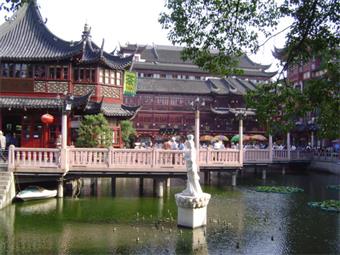
Bright spots along the route
1) Shanghai Old Street
Originally a river directly disgorging into the Huangpu River, Fangbin once played a key role in the development of the Old Town. In 1999, the then People’s Government decided to straighten out the old Miaoqian Avenue, restored the original appearance through “assembling the essence”, and named it Shanghai Old Street.
2) Xundao Street and Tiandeng Lane
Both Xundao Street and Tiandeng Lane have deep-rooted history, for example it is the site of Daotai Yamen, the local jurisdiction supervisor’s official residence. This was the supreme authority of the Old Shanghai, from which Xundao Street derived its name. At each juncture of political evolution, the place here would become the focus of public attention, making it a Mecca for the population at that time. Back then there was no street lamp, so the Daotai Yamen hung a very high lantern, which was called Tiandeng (heavenly lamp), within the tortuous Tiandeng Lane. Nowadays we see a heavenly lamp at each turn, for which it is named Tiandeng Lane. There is a Shuyin Building in Tiandeng Lane, on Xundao Street there was Narcissus Palace and Yijia Hall, only the Temple of the God of Fire is now nowhere to be found. Despite being historical relics, they are scheduled to disappear soon, so we’d better hurry up and pay them a visit!
3) Jiujian-lou
Many people are unaware that Xu Guangqi’s birthplace is in today’s Huangpu District. At No. 234-246 Qiaojia road in the Old Town, there is a row of houses, whose wall is attached with a marble memorial plaque engraved by the Shanghai Municipal Administration Commission of Cultural Heritage. These plaque is saying: “Former Residence of Xu Guangqi in the Ming Dynasty”, this is the place where Xu Guangqi was born and spent most of his life. This row of residences originally has nine houses, in the Song-hu Anti-Japanese War in 1937 two of them were destroyed in the Japanese bombing. Nowadays people still prefer to call it “Jiujian-lou”.
4) Longmen Village
The architectural landscape of Longmen Village far surpasses the Shikumen of Xintiandi, only few people have heard of it because of its hidden location in the Old Town. Longmen Village was named after “Longmen Academy”, despite some skipped street numbers, it is still the deepest and longest lane in Shanghai. Houses here were mostly built in the 1920’s and 1930’s, totaling 76 houses, a unique thing about them is the extraordinarily neat layout and the diversified architectural forms. For example covering Spanish style, Scottish style, ancient Baroque style and Chinese folk houses, a mixture which is very rare even in today’s Shanghai. It is without any doubt a “miniature cluster of multinational residences”.
5) Wenmiao Road and Xueqian Street
Walking to the Xueqian Street, on the walls one can see photos of learned scholars and excerpts of Confucian classical works. The Temple of Literature (Wenmiao), aka “Confucius Temple”, is the only ancient building cluster paying homage to Confucius in downtown Shanghai. Also it is one of Old Town’s most famous existing heritage sites with more than 700 years of history. Today it is the paradise of gourmets and model kits fans.
6) Menghua Street
At Menghua Street, acclaimed as “a living Shanghai old folk town”, one can experience the life scenes of old Shanghai.
7) Dajing Pavilion
Inside today’s Shanghai Old Town, there is a road called Dajing Road running from east to west, it starts from South Henan Road in the east and ends at Renmin Road in the west. It derives its name from the Dajing Archery Tower on the ancient city wall of the Old Shanghai. Later a Dajing Guandi Temple was built at the site of the Dajing Tower. The place here is also the site of the last preserved parts of the old city wall in Shanghai. It is said that climbing the Tower to view the white landscape in the distance after a heavy snowfall provides “Jiang Gao Ji Xue”, one of the “Shanghai Eight Views” in the old days.

Stroll • Banks of Suzhou River
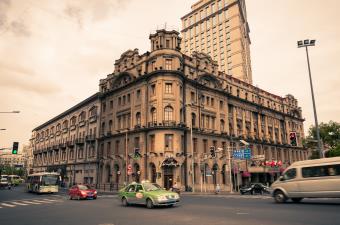
Bright spots along the route
1) Yuanmingyuan Road
“Bund Origin” refers to Yuanmingyuan Road, a short road behind the Bund, walking onto Yuanmingyuan Road, one will be greeted by simple red brick wall and dark Jiulong granite ground. As the origin of the Bund “International Architecture Expo”, Yuanmingyuan Road has 14 old houses, which still keep their styles in the 1920’s and 1930’s.
2) Former British Consulate in Shanghai
As the oldest building in the Bund Origin, the former British Consulate in Shanghai located at No. 33 East Zhongshan First Road has over 140 years of history , it is also the center of Bund Origin.
3) Astor House (Pujiang Hotel)
In 1882, China’s first electric lamp was lit here; in the same year, Western circus debuted here. In 1894, the earliest dance party in China took place, this party to celebrate the 60th birthday of Empress Dowager Cixi. In 1901, China’s first telephone call was put through here; In 1908, the first Western movie was screened here… These are just some of the past glories in the Astor House! When passing the lobby one can notice several frames of old photos on the pillars: Einstein, Russell and Chaplin. All of them world-class cultural celebrities who have patronized this Hotel in the past.